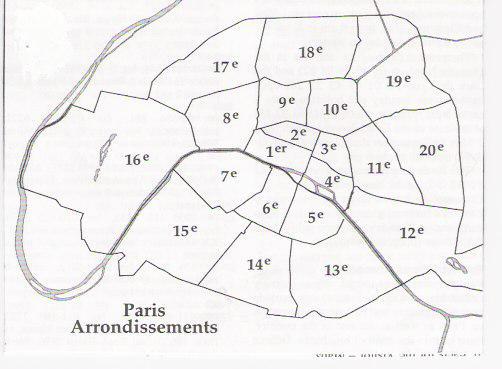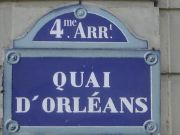An overview of Paris geography will show that it is a relatively flat place. Other than the hill of Montmarte the terrain of Paris changes rather less than a ten story building.
This makes Paris an easy city to walk around and allows you to save your energy for hiking up the stairs of the Eiffel Tower if you choose, or for investigating the miles of halls in the Musee de Louvre.
Paris is oval shaped, approximately 9 miles East to West and 6 miles North to South. There is a road, known as the Periphique, or Perimeter Road that separates Paris proper from the banlieu or suburbs. It is about 22 miles around the Periphique.
The River Seine cuts an arc across Paris, flowing from the Southeast to the Southwest. It is on the islands and along the banks of the Seine that the City grew, so it is there that you will find the oldest areas of Paris and the main tourist attractions.
The North side of the river is called the Right Bank or Rive Droite(say "reeve dwat") and the South side of the river is called the Left Bank or the Rive Gauche (say "reeve go-shh") If you are directionally impaired, look into the river and face with the water going away from you. You are facing downstream. The Left Bank is on your left and the Right Bank is on your right. See, didn't I promise you good information?
Paris is divided into 20 sections called Arrondissements and they are numbered 1 to 20. The first and oldest arrondissement, the center of the city includes a goodly portion of the Ile de la Cite (say "eel day la sit-ay"), and the near Right Bank.
The other arrondissements spiral out from this center in a clockwise direction. Each arrondissement is divided in quarters or Quartiers (say "cart-tea-ays") making for 80 distinct neighborhoods within the City.
See this map:

This is the basic map of Paris. Get familiar with it. You will see many different permutations of it all over the city. This is the first layer so to speak.This same basic map will be over-laid with a metro map for the subways, a street map, a monument map, a department store map. Whatever your interests you will find a map like this with those interests highlighted on it.
Maps are plentiful and free in Paris. Of course some are better than others. The Metro hands out a variety of maps at the ticket window or guichets (say "ghee-shay"). I recommend the Plan 1. It is a large easily read map of the metro, bus and train systems.
But for walking you really need a good street map. Now, I've found that a choice of a comfortable map is a personal matter. I have two recommendations. - For those who prefer a fold out map the Michelin Paris Plan 1/10,000 is a great map. The streets are clearly marked, as are many of the monuments, sites and museums.
- For those who prefer a book format the A. Leconte Edition of Paris Ref.# 415 is my choice. It is loaded, easy to read and easy to put away.
You should be able to get the Michelin map at any good bookstore in the states. You can also get these maps in the book department of BHV, a well known department store across from Hotel de Ville.
Streets signs in Paris are attached to the corner buildings and look like this.

See the number above the street name? That is the number of the arrondissement. Knowing that will help you keep your bearings.
For those who prefer, we offer a very personalized, guided orientation tour. Many of our friends have found it a great way to get familiar with the city.
To learn more click here.
People ask, "When is the best time to visit Paris" and I usually answer that any time is a fine time. But as far as the weather goes, Spring and Fall are the most temperate.The middle of summer can get rather hot and uncomfortable which explains why many Parisians abandone the city to the tourists during August.
That being said, know that because od the ocean influence on Paris a mid summer downpour is not unheard of. The best advice is to keep an eye on the weather forecasts. The weather channel ten day is usually rather reliable. They may not get it completely right regarding rain but they can usually be trusted about the temperature averages.The Paris area has some of the lowest rainfall totals in all of France. Carry an umbrella if it looks unsettled. Or rather, a good book so that you can slip into a cafe and read if it rains. Return to Top


|










